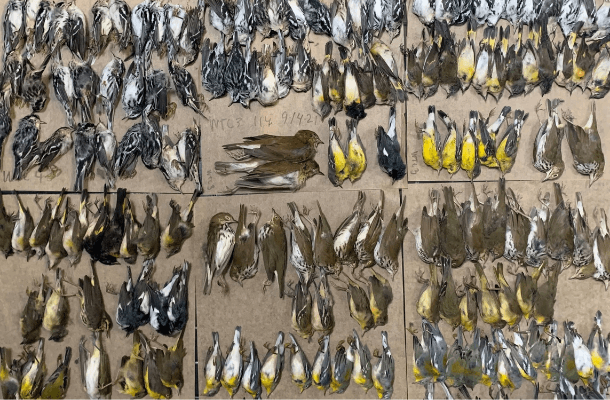Mass Bird Deaths in New York City Due to Storm, Lights, and Glass
Media Contact: Jordan Rutter, Director of Public Relations| jerutter@abcbirds.org | @JERutter

Building collisions are a major threat to birds. The incident at the World Trade Center involving hundreds of migrating songbirds shows just how severe this threat can be. Photo by Melissa Breyer
(Washington, D.C., September 17, 2021) Hundreds of migrating birds died during the night and early morning of September 14 and 15 after colliding with buildings at the World Trade Center complex (WTC) in New York City. American Bird Conservancy (ABC), New York City Audubon, and other partners are already working to engage with managers of the buildings at the WTC complex to remediate their glass, making the area safer for birds.
As many as 1 billion birds die in collisions with glass (i.e. windows, walls) each year in the U.S. Most of these collisions take place during the day, as migrating birds are looking for food to replenish energy reserves and mistake reflections on glass for habitat.
But sometimes a combination of factors creates events like the mass collision at the World Trade Center complex. Because of stormy conditions on Tuesday night, night-migrating songbirds — including the Black-and-white Warbler, Northern Parula, and Ovenbird — flew lower to the ground. It's likely that they were then attracted by bright artificial lights at the World Trade Center site, which, combined with strong winds, produced mortalities as birds tried to land. Birds that survived the landing collided lethally with glass as the sun rose the next day.
“Glass in the built environment is always dangerous to birds and unfortunately, birds are killed by collisions with glass every day. When bad weather brings birds down and lights bring them in, danger and mortality are increased,” says Dr. Christine Sheppard, ABC's Bird Collisions Campaign Director.
“Turning off unnecessary lights can prevent bird deaths,” says Sheppard. “The problem here was a ‘perfect storm' — high numbers of birds aloft, a storm bringing them close to the built environment, lights preventing them from navigating. And then glass waiting for them first thing in the morning."
“New York City's Local Law 15, established in 2020 — requiring that all new buildings follow bird-friendly design guidelines and use bird-friendly glass — will definitely help going forward.”
A 2019 study published in Science reports that the U.S. and Canadian bird population dropped by a net of almost 3 billion birds since 1970. Glass collisions are a major threat to birds, but there are simple actions that anyone can take to help combat this problem. Basic adjustments to both home and commercial windows can save birds' lives. Get resources and ideas to prevent glass collisions here.
###
American Bird Conservancy is a nonprofit organization dedicated to conserving wild birds and their habitats throughout the Americas. With an emphasis on achieving results and working in partnership, we take on the greatest problems facing birds today, innovating and building on rapid advancements in science to halt extinctions, protect habitats, eliminate threats, and build capacity for bird conservation. Find us on abcbirds.org, Facebook, Instagram, and Twitter (@ABCbirds).


















































